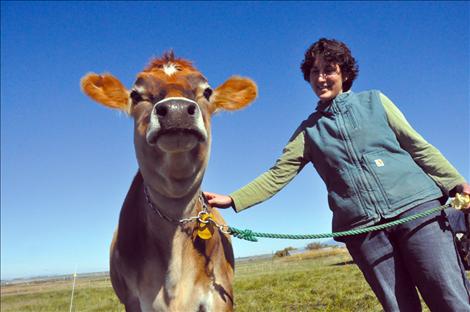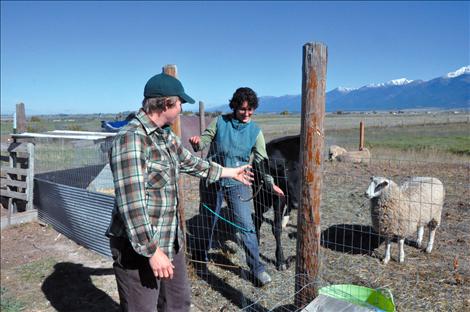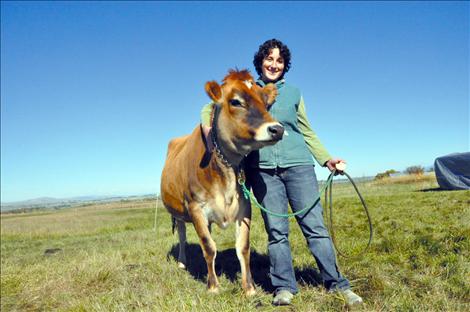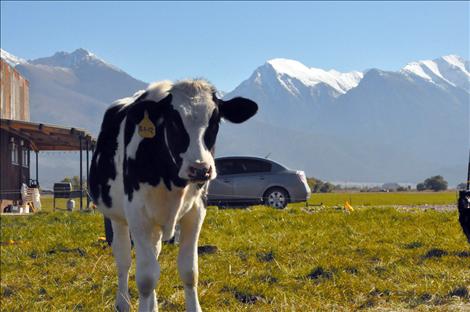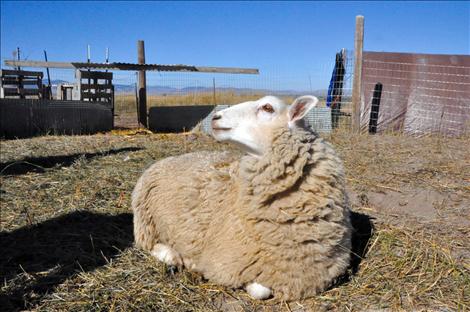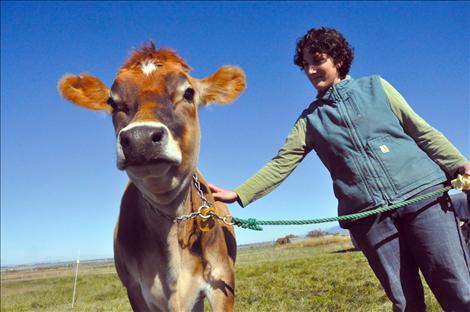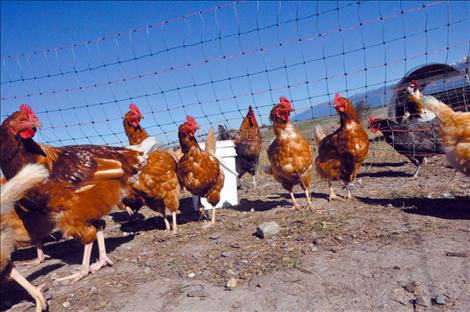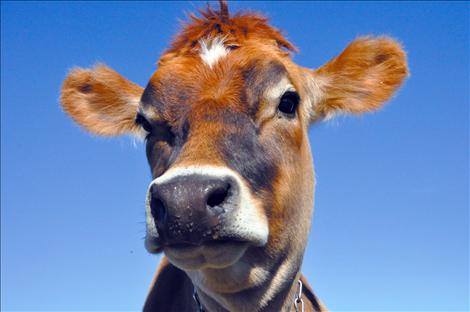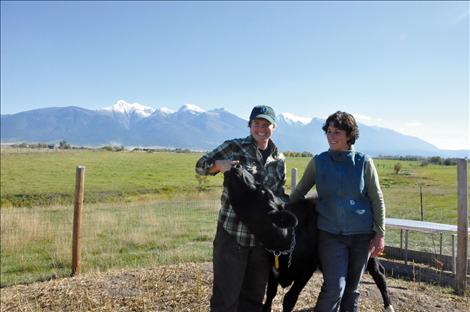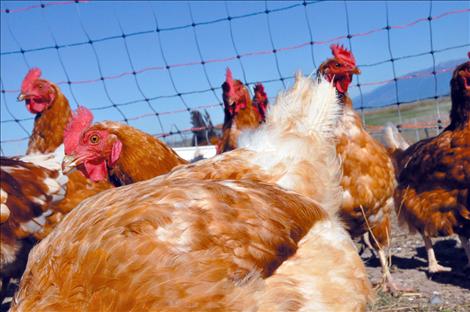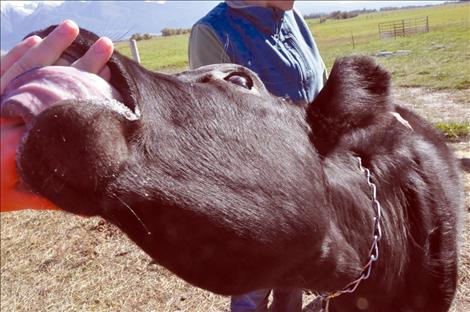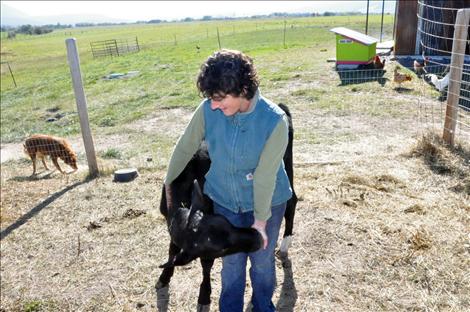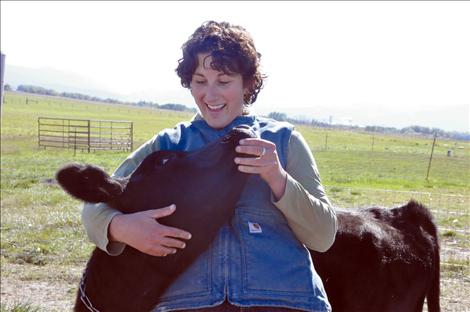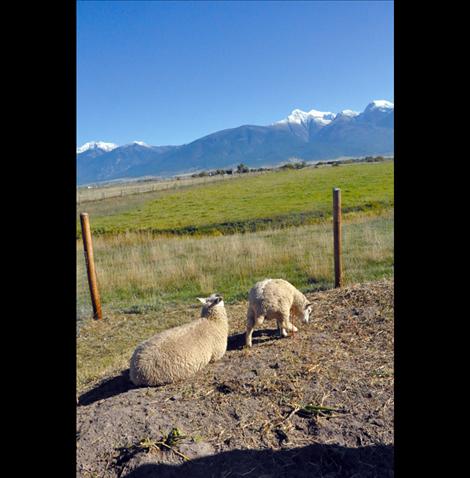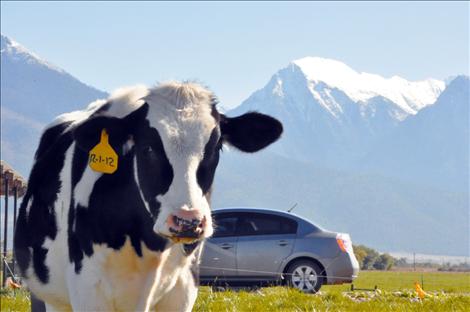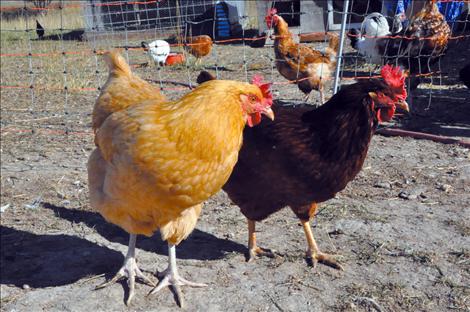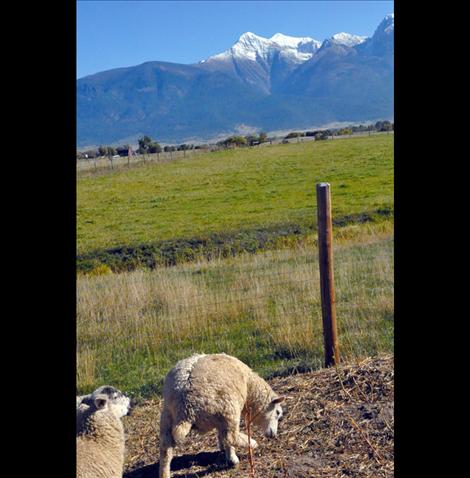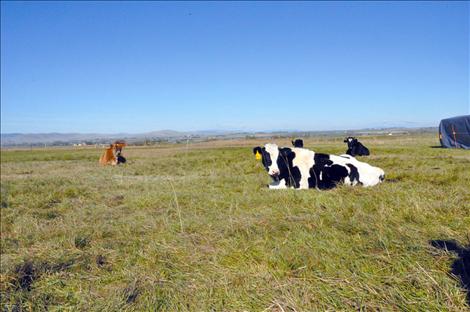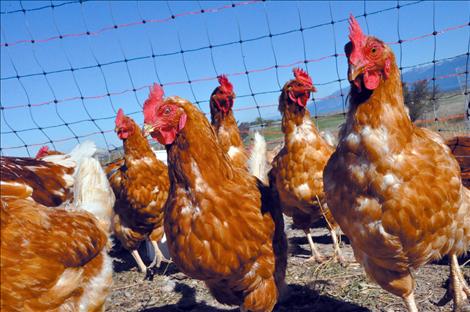Golden Yoke Dairy is Montana’s first in 20 years
Hey savvy news reader! Thanks for choosing local.
You are now reading
1 of 3 free articles.
ST. IGNATIUS – In a green pasture off Pinsonault Road in St. Ignatius, a flock of chickens, two sheep, two steers, a calf and two excited young farmers are waiting out the winter anxiously praying that when springtime comes two calves will be born and revive a once long-standing Mission Valley tradition of small dairy farms, that has all but died out.
“We are really the first brand-new dairy (that is) sourcing everything from scratch in (Montana) in at least 20 years,” said Laura Ginsberg, 30, who began the Golden Yoke Farm and Dairy in St. Ignatius last year with partner Connie Surber, 34.
The pair had a single, Jersey-Holstein crossbred heifer that was shared with another owner when they moved to the property. They’ve since added several other cross-bred cattle, sheep, chickens that lay organic eggs, and a few dogs. The beginning of the Golden Yoke Farm and Dairy was the culmination of a four-year dream the pair shared after years of working for other farms and studying in higher education.
“I grew up on a small farm in Virginia and just absolutely loved the life,” Surber said. “I ended up studying dairy science in school and we just knew we wanted to have our own place.”
Surber worked at other dairy operations when she studied abroad in New Zealand, as did Ginsberg .
“As much as you learn, you see things you would like to do differently and the only way to do that is to have your own place and give it a go,” Surber said.
Surber and Ginsberg have a few things they want to do differently from conventional dairy practice.
Instead of having a huge mega-farm of hundreds of cows that are fed silage to increase production for the liquid milk market, the couple wants to start a small dairy of no more than a couple dozen cows that will provide milk for ice cream made with Montana-made ingredients.
“There’s kind of this bubbling little local foods movement with folks kind of starting to appreciate local foods in Montana and we feel like we are hopefully getting in on the ground floor of something that’s going to be really huge in the next five to 10 years,” Surber said. “We initially thought we wanted to have a dairy to make cheese, but when we thought about our love of dairy, ice cream was just so huge and it just seemed like a lot of fun. Not saying that cheese making is not fun, but ice cream fits our personalities better and everybody loves ice cream. Even people who are lactose intolerant seem to make that exception every once in a while.”
In the kitchen of their farmhouse, Surber and Ginsberg spent the summer throwing different ingredients into their Kitchen Aid mixer, trying to develop different flavors. A few flavors resulted from experimentation with leftovers like peach pie and birthday cake frosting. Others, like rich dark chocolate, Teddy graham crackers mixed with strawberry/raspberry preserves and peanut butter chocolate chip required a little bit more thought.
“We did a Dixon melon once that was really good,” Ginsberg said. “I didn’t think cantaloupe ice cream would be good, but it was awesome.”
Ginsberg and Surber each have their own style of creating a new flavor.
“Laura is an awesome baker and cook and I’m just getting used to it in the kitchen,” Surber said. “She’s much more comfortable with doing wild experimentation with the ice cream and different recipes. I’m still kind of taking baby steps. I like (measuring carefully) and trying to take notes and then saying that next time we’ll try to do more.”
Ginsberg admitted she gets a bit enthusiastic in the kitchen.
“I’m kind of the one that’s like ‘We need more stuff in it,’ and Connie’s like ‘The recipe calls for this.’ I’m like ‘We need more chunks – more, more, more,’” Ginsberg said.
Surber will attend the world’s most renowned ice cream program at the Pennsylvania State University Creamery in January. Funding for Surber’s tuition was paid for by grants from the Red Ants Pants Foundation and the Montana Farmer’s Union.
“One of my friends told me ‘Connie’s going to Sundae School,’” Surber joked.
After attending the program, Surber will return and begin marketing the farm’s ice cream in 2014.
“Our plan is that next year, Connie is going to start making a Montana-sourced ice cream,” Ginsberg said. “It’s going to be made from as many Montana ingredients we can get here, and we’ll make the base ourselves. We’ll start to market ice cream under our logo, but it won’t be our milk. It will be Montana-produced milk. The following year we will start making our pasture-based ice cream.”
Ginsberg received a prestigious Fulbright scholarship to study dairy abroad in New Zealand for the most of 2014, so Connie will shoulder most of the farm’s duties by herself.
The Golden Yoke practices grazing intensive agriculture, so feeding the cattle is a bit more difficult than just turning the farm’s two pregnant heifers, a calf, and two steers out to pasture.
“There’s actually been quite a movement in the valley just in the past year or two of people who intensively graze,” Ginsberg said. “It requires a lot more management, but you get a lot more production. Instead of just putting our cows out in a field, we break our cows into cells that we fence them into. You move them off of that cell within 12 to 24 hours to a new patch. That really stimulates the grass to regrow and it encourages soil health and productivity of land.”
The cells are built with an electrified wire that encircles the area the cattle are grazing in. It takes approximately 15 or 20 minutes to build a cell each day. Ginsberg said the Golden Yoke is able to practice this more sustainable form of agriculture because it isn’t under the pressure to produce huge amounts of milk that large farms that market milk to liquid markets have to contend with.
“The most important thing is that the flavor of our milk is good, the land is healthy, and our cows live a long productive life,” Ginsberg said. “It’s not really new, it’s just how things used to be. It’s a small scale approach.”
The Mission Valley used to be flush with small dairy farmers, according to Ed Bratton, former Lake County Extension agent.
“In the 30s and 40s, practically every farm was milking cows,” Bratton said. “There were major creameries in Missoula, Ronan and Polson. They were making butter and cheese.”
Most of the dairies had fewer than 16 animals, Bratton said. The creameries would run a route at least every three days and pick up the milk from the dairies and take them from the farm to the creameries.
As farmers converted to machinery farming from horse farming, they began switching operations to large fields of grains and potatoes or beef cattle. At the same time, regulations on producing milk for consumption were tightened and became too pricey for dairies.
The number of dairies dropped gradually from dozens in the early 20th century, to just 10 in year 2000, Bratton said. Today, there are only three dairies in Lake County, including the Golden Yoke. The other two facilities are large farms.
According to the 2011 Montana Agricultural Statistical Handbook, Lake County ranked third in Montana for the number of dairy cattle, with approximately 1,100 heifers and calves. In contrast, there were 27,000 head of beef cattle in the county that outnumbered humans.
With those numbers, it’s no surprise all of the animals shown by children at the Lake County Fair this year were beef steers. There wasn’t a single dairy entrant. This situation wasn’t always the case, Bratton said.
“At the different fairs throughout Western Montana there used to always be a number of dairy animals competing,” Bratton said. “Back in the 30s and 40s there were more dairy animals in Western Montana than beef cattle.”
The Golden Yoke will have an open-gate policy and hopes that children will volunteer to show the dairy’s animals in the Lake County Fair.
“Education is a huge part of our mission,” Ginsberg said. “We want to be involved with FFA and 4-H. We want kids to show the cows if they are interested. That’s a big part of this dream for me. You go to the shows here and there’s a dairy category with no cows. I really want the dairy show to be revived because I think it’s different than raising a steer. You don’t get rid of your animal after the show. You can bring her back and show the next year and the year after that.”
Ginsberg and Surber want to connect with former and aspiring dairy farmers as they build their farm. They are particularly interested in talking with people who have old equipment that is not in use.
The farm will not be a state-certified dairy until it can obtain the proper equipment. To generate revenue to buy that equipment Ginsberg and Surber will use the proceeds from 2014’s ice cream sales.
To be able to sell enough ice cream to raise the revenue, Ginsberg and Surber need a commercial ice cream maker. The couple estimates it will take $7,000 or $8,000 to buy a used, 16-pint machine. They have set up a Kickstarter campaign to raise funds for the ice cream maker at www.kickstarter.com/projects/thegoldenyoke/the-golden-yoke-dairy-ice-cream-for-good.
Once the ice cream making is underway, Surber and Ginsberg hope they can give back to the community that helped them get started. They plan to develop flavors that fit the theme of non-profits, and donate a portion of profits made from those flavors to the non-profit.
The Montana Conservation Corps is a group that dear to Surber because she worked with them. She already has their flavor underway.
“A good friend that was in MCC with me said it should be about dirt and sweat, so we’re going to try out an Oreo, salted-caramel flavor and see how that turns out,” Surber said.















